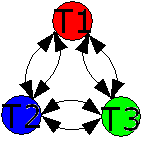Cybernetics
theory of communication and control based on regulatory feedback From Wikipedia, the free encyclopedia
Remove ads
Cybernetics[1] is the study of control and communication in the animal and the machine.[2] Norbert Wiener added: "Information is information, not matter or energy".[2]155

Ross Ashby defined it as: "the art of steermanship... co-ordination, regulation and control will be its themes, for these are of the greatest biological and practical interest... it treats, not things but ways of behaving. It does not ask “what is this thing?” but “what does it do?”[3] Ashby continued:
- "Cybernetics stands to the real machine—electronic, mechanical, neural, or economic—much as geometry stands to a real object in our terrestrial space".[3]
Louis Couffignal said cybernetics was "the art of ensuring the efficacy of action".[4]
Cybernetics was from the first an inter-disciplinary field of study. It included people from at least a dozen academic disciplines. There were two events which sparked it off after World War II. The first was that scientists from different backgrounds had, during the war, worked together on various military projects. They learned a good deal about how to cooperate with their various partners. The second event was the invention of computers during the war.
The countries which started cybernetics were Britain and the United States, but the idea spread quickly to France, Russia and other countries. Another, more famous, example of 'interdisciplinary studies' was molecular and cell biology.
Remove ads
The building block
Imagine a simple system such as a central heating system.
A goal-directed or control system has these four parts:
- Sensor (S): test the system's environment.
- Goal (G): the specification of the desired state of the system.
- Error Detection (E): a method for finding the difference between the present state and the goal state.
- Effector (E'): operations the system can make to get the environment closer to the goal.[5]
The device which does this is called a thermostat.
Remove ads
Later years
Cybernetics started rapidly, and some of the greatest thinkers of the post-war era were interested in it. When this generation died, and some of the hopes for artificial intelligence and robotics were slow to produce results, cybernetics fell somewhat out of favour.[6]
Related pages
- Feedback
- Homeostasis
- Self-organisation
- General systems theory
- Technological singularity
References
Wikiwand - on
Seamless Wikipedia browsing. On steroids.
Remove ads
